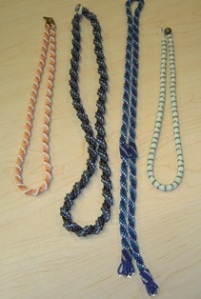I know I usually blog about my experiences with knitting, but I do still do some beading as well. It has become difficult in recent years do to aging eyes, but I do still enjoy it almost as much as knitting. So today I am going to talk a bit about the first off-loom bead-weaving technique I learned; Crochet Beaded Rope.
This fun technique is enjoying a bit of a resurgence and I couldn’t be more pleased. It is still my favorite technique because it is so portable. All your beads are pre-strung before you get started so once strung you can take your project anywhere. When I was first doing these necklaces it wasn’t unusual to see me working on one in doctor’s office waiting rooms and even in restaurants. Here are a few of the necklaces I have made.
As you can see I definitely prefer to go simple with my designs. Most of my ropes are simple spiral designs but I do have the stray striped design. Other bead artists have taken the art form to some extreme heights with very elaborate patterns. Some even have patterns that do not repeat. Because you have to string your beads in advance according to pattern, planning the pattern out in advance is necessary. These elaborate designs awoke a question in my mind this morning about planning. I have seen some books with these patterns graphed out in them. Beading graphs are used for lots of techniques, especially peyote stitch. There are even sites on the internet where you can download free files of these graph papers. But I have never seen graph paper for crochet beaded ropes.
So what do you do if you have an elaborate pattern in mind that needs to be graphed out? It occurred to me that with a little modification you can adapt other graph paper to be used for planning out a crochet beaded rope pattern. My first thought was to try and use peyote graph paper. Note: The picture below was taken from a graph paper obtained from Fire Mountain Gems website.
When I looked at the paper above I realized that the orientation of the “beads” in it are turned 45 degrees from the orientation of the actual beads in the rope. I first thought I could turn the graph and then put diagonal lines in to mark off my “territory” when the light bulb came on and I realized that brick stitch is the correct orientation. So I then downloaded a brick stitch graph, pictured below, and again taken from a Fire Mountain Gems website graph.
Now what do I do?
To start planning your rope you need to block off the pattern in the needed width. If you want a rope that is 6 beads around, you will need to draw parallel diagonal lines on the paper that are 6 beads apart. Whatever the bead circumference for your rope will be, that is how many beads wide you need to block off on your pattern. Once the tedious part of the job is done, the fun begins! Start coloring in your pattern with coloring pencils. I recommend using pencils that are erasable because you will likely want to make changes as you go.
After you are done with your design then you are ready to start stringing your beads. I usually recommend reading the graph from the bottom up but you can do it either way. But do you read from left to right or right to left? Assuming you want the finished rope to look exactly like the graph it is very important you string correctly. The correct way depends on if you crochet left handed or right handed.
If you crochet right handed: read your graph left to right and bottom to top or right to left and top to bottom.
If you crochet left handed: read your graph right to left and bottom to top or left to right top to bottom.
If you do not know how to do this fabulous technique, we will be offering regular classes starting in April. Or you can schedule a one-on-one.


